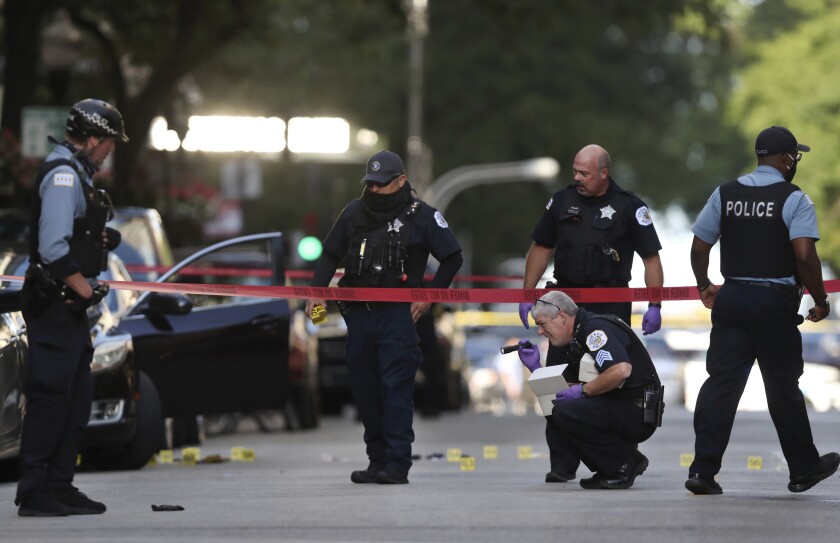Will the Crime Wave Soon Crest?
By Barry Latzer
The Wall Street Journal
January 2, 2022

Across the U.S., 2021 was a bad year for crime. The New York City Police Department reported a 4.1% increase in homicides over 2020. Chicago’s increase was 5% and Los Angeles suffered a 13% rise in killings. The 2021 figures follow a scary 2020, when the nationwide homicide rate (6.5 per 100,000) was the highest in 23 years.
The pandemic, along with dubious criminal-justice system reforms, undoubtedly made things worse. Covid made police reluctant to interact with suspects except when making arrests for serious crimes. Wholesale releases from jails like New York’s Rikers Island put offenders back on the streets. Some states adopted bail reforms that kept offenders from jail entirely. It didn’t help that a new crop of progressive prosecutors, in misguided efforts to reduce so-called mass incarceration, declined to prosecute numerous misdemeanors and agreed to light sentences even for some violent felons.
But the pandemic won’t last forever, and a backlash already is stirring against reforms that fostered crime. The question is whether the factors cited above are the real reasons for the crime surge, or whether they mask longer-term trends pushing the country toward another 25-year crime wave such as the one that horrified the nation from the late 1960s to the early 1990s.
Thankfully the key factors that caused that wave—which I call a crime tsunami—aren’t present today.
The crime tsunami that began in the late ’60s was driven largely by three factors: large-scale rural-to-urban migration of African-Americans and immigration to big cities of Hispanic populations with high violent-crime rates, massive growth in the youth population, and a weak criminal-justice system. One might throw in a fourth: The crack-cocaine epidemic, which sent crime soaring after it began to ease in the early ’80s. These elements aren’t present today, though attempts to weaken the criminal-justice system are worrisome.
Take immigration. The current immigrant population is characterized by low violent-crime rates. In Los Angeles, for instance, Asians are nearly 12% of the population, but they were only around 2% of the homicide victims in 2021. Racial data for perpetrators in Los Angeles aren’t available, but given the strong tendency of violent criminals to assault members of their own social groups, it is safe to conclude that Asian murderers are also a tiny proportion of the population.
Hispanic immigrants have much higher crime rates than Asians, but their rates aren’t out of proportion to their population numbers. In 2020 native and immigrant Hispanics were 11% of murder suspects and 12% of the victims nationwide, but they made up more than 18% of the U.S. population. By contrast, blacks, who were 13% of the American population, were half of the homicide offenders and 56% of the victims.
Yet a little-noticed migration trend may reduce crime in the next decade: a significant movement of African-Americans out of big cities. If this trend continues, it could portend reductions in crime. Low-income blacks, especially young males, commit a disproportionate amount of the violent crime in this country. That’s why their migration in the ’60s raised crime rates in cities. A recent analysis of census data by Politico found that from 2010 to 2020 nine of the 10 cities with the highest proportions of blacks (Houston was the exception) were losing minority population. Some declines were dramatic: Detroit lost more than 277,000 of its African-American residents, Chicago more than 261,000 and New York in excess of 176,000. Unless immigration and migration patterns change in coming decades, this factor is unlikely to support a new crime tsunami.
A second consideration is age distribution. The American population is aging, and the once-violent baby boomers have mellowed considerably. In 2021 more than 21% of Americans were baby boomers and the 65-plus age group is projected to constitute more than a fifth of the population through 2060. Meanwhile, men 18 to 24 are a declining proportion of Americans. In 2020 they were an estimated 4.7% of the U.S. Their proportion is projected to decline to 4.5% in 2025 and 4.4% in 2030. Though these declines aren’t dramatic, the downward trajectory augurs well for violent crime forecasts.
The final consideration is the strength of the criminal-justice system. In response to rising crime in the 1970s and ’80s, the system was built up with more police, more prisons and longer sentences. In recent decades imprisonment rates have been falling, mainly because of successful crime reduction, though the decarceration movement has played a role. The imprisoned percentage of the population is at a 25-year low and the black imprisonment rate tumbled 29% from 2009 through 2019. But the pressure to make further reductions is strong and the recent election of district attorneys with qualms about incarcerating criminals suggests that the public in many big cities supports shrinking the system more.
If policy makers keep the justice system strong enough to cope with the latest crime surge, then the U.S. stands a good chance of avoiding the sustained mayhem that tore the country apart for decades.
1 comment:
It ain't rocket science. The reason for the crime wave is more criminals on the streets and fewer criminals in prison.
Post a Comment